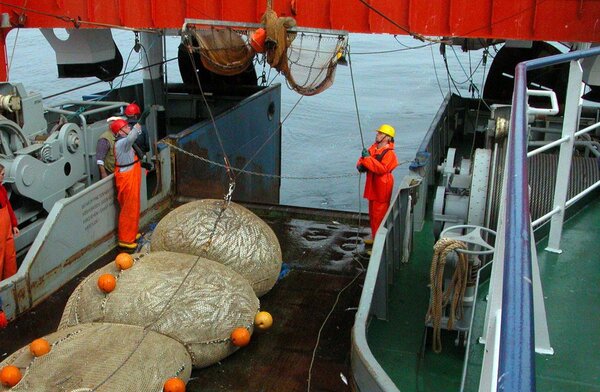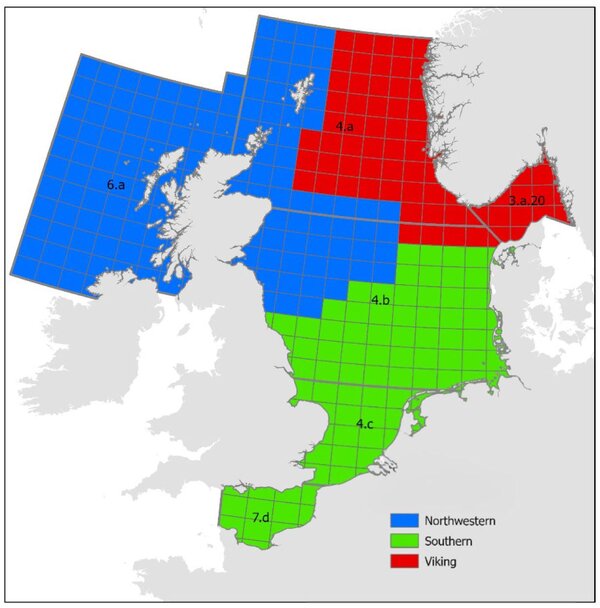Expertise
ICES advice on fishing opportunities: What's behind it?
Alexander Kempf, Holger Haslob, Jens Ulleweit, Norbert Rohlf, Matthias Bernreuther, Christoph Stransky, Karl-Michael Werner, Uwe Krumme, Christopher Zimmermann, Sven Stötera, Stefanie Haase, Kristina Barz | 05.11.2025
In its annual reports, ICES provides an overview of the status of exploited fish stocks in the North-East Atlantic and issues advice on total allowable catches. We explain what the recommendations mean for German fisheries and why they are at a certain level.
Every year, the International Council for the Exploration of the Sea (ICES) publishes scientific advice on the state of fish stocks in the North-East Atlantic ("ICES Advice") and proposes sustainable catch quotas for the following year. In the following, we explain the status of the most important fish stocks for German fisheries and the scientific catch quota recommendations based on this.
Fortunately, the status of many fish stocks in the North-East Atlantic and adjacent areas has improved in recent years. Due to the reduction in fishing pressure, the biomass of many stocks is showing a positive trend. From 2003 to 2022, the biomass of stocks with sufficient data increased in the North-East Atlantic by an average of 37 %. However, the range in the development of individual stocks is wide and for some stocks also negative (e.g. cod in the southern North Sea). Many stocks in EU waters are managed sustainably according to the principle of maximum sustainable yield (MSY), even if the MSY target has not been achieved for all stocks. In 2022, 40 out of 65 stocks for which corresponding reference values are available had achieved the MSY criterion. This corresponds to 62 % of the assessed stocks, compared to only 30 % in 2003. The average fishing mortality rate in 2022, averaged over all stocks, was 42% below the MSY values, while in 2003 the reference points were exceeded by 53% on average. This indicates that the level of exploitation has decreased significantly and only individual stocks are still affected by severe overfishing (data source: STECF Report 2024).
Fishing mortality is a measure of the amount of fish or other marine living resource taken by catch from the harvestable portion of a stock over a given period of time.
The recovery of stocks also has positive economic effects. With fuel prices falling again to some extent since 2022, most fleets in the EU member states are expected to be profitable in 2024. Nevertheless, there are individual fleets that face major challenges as they have very high fuel consumption (e.g. beam trawling for flatfish in the North Sea).
Explanations on the ICES advice for 2025/2026
Cod on the northern shelf has been divided into three sub-stocks (southern sub-stock, north-western sub-stock and Viking sub-stock) two years ago. Workshops to clarify the stock structure of cod in the North Sea and west of Scotland have shown that the three sub-stocks differ genetically and/or in their biological characteristics (e.g. growth, maturity). The population sizes of the sub-stocks have also developed differently. In particular, the southern sub-stock has developed worse than the north-western and Viking sub-stocks. For these reasons, ICES considers an assessment based on the sub-stocks to be appropriate.
According to the available stock assessment, all three sub-stocks were fished above FMSY in 2024. While the north-western and Viking sub-stock have an increased risk towards safe biological limits at the beginning of 2025, the southern sub-stock is clearly outside safe biological limits and below the Blim biomass limit. Since the southern sub-stock in particular marks the southern limit of the cod distribution area, it is very likely that climatic changes play a role in addition to fishing.
The calculations based on the three sub-stocks assume that the sub-stocks do not mix in the first quarter, as they remain in their respective sub-stock areas (Figure 1) during the spawning season in the first quarter. In quarters two to four, however, the sub-stocks mix considerably.
It is therefore not possible to make recommendations based on the MSY approach for each of the three sub-stocks, as no (genetic) data are available to quantify the mixing of the sub-stocks in quarters two to four. A management recommendation at the sub-stock level is also not feasible for management, as without knowledge of the spatial distribution and mixing of the sub-stocks in quarters two to four, compliance with the recommended catch levels for all sub-stocks could not be guaranteed.
A zero catch (zero advice) was recommended for the maximum catch limits in 2026, taking into account considerations within a precautionary approach. The main problem is that the southern sub-stock is in very poor condition. The question of whether the lack of knowledge about the mixing of sub-stocks necessarily means that a strict "zero advice" must also be given for the north-western and Viking sub-stocks has been debated at length within ICES. Without further consideration within a precautionary approach, ICES recommends a catch of 8,670 tonnes for the north-western sub-stock and 3,610 tonnes for the Viking sub-stock. However, due to by-catches from the southern sub-stock, this scenario leads to a high probability that it will remain below the limit biomass (Blim) until 2027.
To improve the quality of the assessment and prevent the need to apply a precautionary approach and reduce potential catches under the MSY approach, genetic samples and analyses at a high level of spatio-temporal detail would be necessary. This would make it possible to calculate how stocks mix in individual quarters and when catches are made in which areas. This would also allow targeted measures to be taken to protect the southern sub-stock. However, this would require considerable resources and funding.
The explanation of the Northern Shelf cod as a PDF download
Contact: Dr. Alexander Kempf

The stock is estimated to be just above Blim at the beginning of 2025. The stock was fished just above FMSY in 2024. Compared to the 2024 assessment, this is a significant downward correction of the spawning stock biomass. The main reason for this is a significantly worse development of the average weights per age class than assumed in last year's predictions.
The productivity of the stock has been lower in the last 10 years than in previous decades, suggesting unfavourable environmental influences. The average weight of the animals has also fallen over the last 5 years, which also points to unfavourable environmental conditions and a lack of food availability.
ICES recommends a maximum catch of 60,167 tonnes for 2026 based on the MSY approach. This corresponds to a reduction of 24% compared to last year.
All major fleets fishing directly for saithe recorded a decline in catch rates compared to the years around 2015. Between 2020 and 2023, there is a reversal of the trend and a slight upward trend in catch rates again. For 2024, however, the French fleet in particular shows a decline in catch rates, while Norwegian catch rates show only a slight downward trend and German catch rates have even increased. This reflects the fact that the three fleets fish in different areas (e.g. France in the north-west of the stock area). However, interpreting commercial data is not easy, as changes in fishing patterns can also result from economic considerations. This increases the uncertainty of stock calculations. Since the scientific survey is not specifically focused on saithe, the assessment is considered uncertain overall.
The explanation of the saithe in the North Sea as a PDF download
Contact: Dr. Alexander Kempf
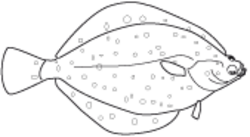
Due to a sharp decline in fishing effort by the main flatfish fishing fleets since the early 2000s, fishing pressure on plaice has fallen significantly since then. Massive scrapping programs in the Dutch fleet have continued this trend in recent years. Since 2019, fishing pressure has been below FMSY and in recent years even well below it. The recruitment rate determined since 2010 has mostly been above average. The spawning stock biomass has increased significantly over the last two decades and is currently only slightly below the highest value since records began in 1957. Due to natural variability in offspring production, the stock fluctuates well above all biomass reference points.
The ICES (International Council for the Exploration of the Sea) catch recommendation based on the MSY approach for 2026 is no more than 164,129 tons for plaice from the North Sea and Skagerrak combined. This is slightly below last year's recommendation (-7.3%), mainly due to a redefinition of the reference points. Total catches in recent years have always been well below the recommended maximum catch, as it does not appear profitable to fish the quotas. High fuel costs are likely to further worsen the situation for flatfish fishermen.
The explanation of Plaice in the North Sea as a PDF download
Contact: Dr. Holger Haslob
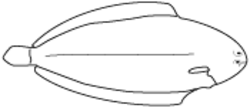
Following a high in the early 1990s, the spawning stock biomass of sole in the North Sea showed a generally declining trend until 2005. After this low point, the stock recovered slightly, but remained below the critical reference value Blim for a long time. Due to a stronger 2018 year class, the spawning stock biomass has increased in recent years and the stock is just within safe biological limits at the beginning of 2025. Fishing mortality (F) has decreased overall since 2005, but was well above the FMSYreference value for a long time. Only since 2020 a strong reduction has been recognizable and for 2024 the fishing mortality rate is well below FMSY. This development was also supported by a massive scrapping program in the Dutch fleet.
The estimated production of young fish shows less strong cohorts in the last decade than in previous decades. However, as already mentioned, the 2018 cohort is somewhat larger. This larger cohort currently accounts for the majority of the fishery. The 2024 cohort also appears to be slightly higher again.
ICES calculates a maximum catch of 12,454 tons for 2026 based on the MSY approach. This means that the recommended maximum catch is 16% higher than last year's recommendation.
The explanation of sole in the North Sea as a PDF download
Contact: Dr. Holger Haslob

The spawning stock biomass of North Sea herring has fluctuated between 1.1 and 2.4 million tons since the late 1990s. Since 1996, the spawning stock biomass has been within biologically safe limits and fishing mortality has been consistently below FMSY, but has risen above FMSY in 2024.
Despite sufficient spawning stock biomass, the number of herring offspring has been below average since 2003. Only in 2013 a stronger year class was produced. Catches of herring larvae at the spawning grounds show that sufficient larvae are still hatching. However, compared to previous times smaller numbers reach the juvenile herring stage. The reasons for this are not fully understood. As a result of lower recruitment, the stock has declined in recent years but will remain within safe biological limits in 2025. However, the forecast shows a further decline in the stock outside safe biological limits (below MSY Btrigger and Bpa), even if the ICES MSY approach is followed. A new trilateral management strategy was evaluated for the stock in 2025, and ICES was asked via a “special request” to adapt the recommendation to the new management options.
For 2026, ICES recommends a maximum catch of 287,772 tons (of which 282,724 tons are for human consumption) based on the MSY approach. This is 27% less than the maximum catch limit set in 2024 for the fleet for human consumption and 30% less than last year's ICES recommendation.
In addition to fishing for human consumption (A fleet), there is also industrial fishing in the North Sea for the production of fish meal and fish oil (B fleet). Since young herring are mainly caught as bycatch in sprat fishing, this fleet segment is subject to its own maximum limit for herring bycatch (5,048 tons for 2026, according to the ICES recommendation). In addition, herring stocks from the North Sea and Baltic Sea mix off the southern Norwegian coast, in the Skagerrak/Kattegat and in the western Baltic Sea, and are caught together. Due to the poor stock situation, ICES recommends a fishing ban for Baltic herring from the western Baltic Sea, the Skagerrak, and the Kattegat in 2026. Therefore, the corresponding recommendations for catch quotas for North Sea herring in the areas mentioned (so-called C and D fleets) have also been set to zero.
The explanation of herring in the North Sea as a PDF download
Contact: Dr. Norbert Rohlf

The biomass of the spawning stock of Northeast Atlantic mackerel has increased substantially since the 2000s, peaking in 2014, but has since declined sharply and is estimated to be outside safe biological limits and even below the limit biomass (Blim) in 2025. Fishing mortality was below FMSY for a long time, but has risen significantly above the reference value in recent years. Since the early 2000s, several large year classes have developed. As a result of increased biomass and climatic changes, the stock has expanded significantly in a northwesterly direction (Iceland, Greenland) since the late 2000s, particularly during the long feeding migrations in summer. However, this process does not appear to be continuing at present. Low reproduction rates since 2017 have contributed to the decline in the stock, which has retreated to its core areas.
An age-based model is used to estimate the stock. In addition to commercial data, this model uses the triennial mackerel egg survey, which targets spawning aggregations, and, for several years now, a Nordic survey that records the stock during its feeding migration. In addition, the International Bottom Trawl Survey (IBTS) is used in the fourth quarter and first quarter to estimate the recruitment situation. Norwegian tagging data, which estimates stock size based on recapture rates, has also been integrated into the assessment in recent years. In 2025, another benchmark was established, which has optimized the use of the various data sources and has adapted the biological data, such as natural mortality, to the latest findings.
The latest scientific recommendation sets a maximum catch for 2026 of 174,357 tons, which is 70 percent below the previous year's recommendation of 576,958 tons. In recent years, however, fishing nations (e.g., EU countries, Norway, Iceland, the Faroe Islands, Greenland, Russia) have been unable to agree on a common maximum catch, and the unilaterally set quotas and total catches significantly exceed scientific recommendations. Mackerel is also fished in international waters, which makes management even more difficult.
The explanation on mackerel in the North-East Atlantic as PDF for download
Contact: Jens Ulleweit
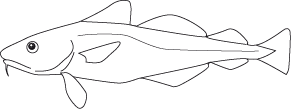
As Russian scientists are currently excluded from ICES work, no stock assessment has been carried out within ICES in recent years.
The explanation of cod in the East Arctic as a PDF download
Contact: Dr. Matthias Bernreuther

The German fleet mainly fishes for redfish on the Greenland Shelf and, until 2020, in the Irminger Sea. Two redfish species, the beaked redfish (Sebastes mentella) and the golden redfish (Sebastes norvegicus, formerly Sebastes marinus), occur in several stocks there. The status of these stocks varies. The two species are also caught together on the East Greenland Shelf. It is often difficult to distinguish between golden redfish and beaked redfish, resulting in misreporting between the co-occurring species or both species being reported together as "redfish". This complicates the assessment and management of stocks.
The golden redfish stock on the East Greenland Shelf is part of the stock largely found on the Iceland Shelf. The spawning stock biomass has been within safe biological limits since 2003 and has been fished according to the MSY principle since 2006. The ICES catch recommendation of no more than 41,345 tonnes for 2026 is 11.9% below the recommended maximum catch for 2025. and follows the ICESMSY approach. In the medium term, however, the production of young fish is a cause for concern, as it has been low since 2014. It is expected that the spawning stock biomass will decrease in the future as a result.
The exact status of the beaked redfish stock on the Greenland Shelf cannot be accurately assessed. The stock has declined sharply since 2010 and has not improved in subsequent years. As the most recent values for the biomass index of the Greenland Shallow Water Survey have been close to zero in recent years, ICES recommends zero catches from this stock for 2025 and 2026.
In the neighboring Irminger Sea, there are two other beaked redfish stocks that are caught with pelagic trawls. These two stocks have also declined so sharply that ICES has recommended zero catches for the shallow stock since 2010 and for the deep stock since 2017. In 2021 and 2024, the stock status of the shallow beaked redfish stock in the Irminger Sea was assessed again for the first time since 2013. The result of the survey was slightly more positive, as the resulting biomass index showed the highest value since 2005, but remains at a historically low level below possible reference points. Despite the slightly more positive assessment, the recommendation of a zero catch remains until 2027. The deep stock (> 500 m water depth) has been fished since the 1990s with a fishing mortality rate well above FMSY. The results of the stock assessments indicate very low values below Blim for the deep stock in 2024, and a zero catch is also recommended until 2027. While Russia, for example, continues to fish these stocks, the EU currently does not allow fishing for either stock.
The explanation of redfish in the Greenland/Irminger Sea as a PDF download

On the Norwegian shelf, in the Norwegian Sea and in the Barents Sea, there are two redfish species of commercial importance: the beaked redfish (Sebastes mentella) and the golden redfish (Sebastes norvegicus).
The beaked redfish stock is very likely in good condition. The spawning stock biomass increased steadily between 1992 and 2005 and has since stabilized at a high level. As Russian scientists are currently excluded from ICES work, no stock assessment has been carried out within ICES in recent years.
In contrast, the golden redfish stock (Sebastes norvegicus) found on the Norwegian shelf and in the Barents Sea is currently in a poor state. The spawning stock biomass has declined continuously since the late 1990s and is at the lowest level in the time series below critical biomass reference points. ICES therefore recommends zero catches for the years 2025 and 2026. In addition, ICES recommends minimizing bycatches of golden redfish in other fisheries, such as for cod and saithe. Nevertheless, over 10 000 tons per year were caught internationally in 2022 and 2023.
The explanation of redfish in the Norwegian Sea/Barentssea as a PDF download

A benchmark in 2023 used new genetic information to divide the cod stock complex off Greenland into three stocks.
The west Greenland coastal stock lives in the extensive fjord systems and is divided into a northern and southern stock component. In the offshore stocks, a distinction is made between a West Greenlandic and an East Greenlandic-Island offshore stock based on genetic stock assignments. Historically, the heyday of cod fishing off Greenland in the 1950s and 1960s was associated with a very large western high seas stock, while the recovery since 2000 is due to a strengthening of the eastern high seas stock and/or increased exchange with the Icelandic stock. Overall, the stocks in Greenland waters mix during different life stages. It is therefore difficult to attribute catches from the fishery directly to a stock. Only a subsequent genetic analysis can provide more clarity.
After the collapse in the early 1990s, there was a 10-year period of very low population densities. After a moratorium until 2005, fishing was permitted again in 2006.
For the East Greenland stock, a solid stock calculation is currently not possible, as seasonal migrations between East Greenland and Iceland prevent separate calculations. Mixing with the Icelandic stock probably explains why the majority of catches in East Greenland currently come from Dohrnbank, which is located in Greenlandic territorial waters between East Greenland and Iceland. Due to a lack of information, the recommendation of an annual maximum catch of 23,518 tons for the years 2024 to 2026 is only based on a reduction of 20% (precautionary buffer) compared to the observed catch in 2022.
The West Greenlandic offshore stock is at a low level, but above the critical biomass limit. Fishing pressure is too high based on the MSY concept. The catch advice for 2026 based on the ICESMSY approach is 4,708 tonnes. This represents a 45% increase compared to last year's recommendations and is mainly driven by a higher assessment of the strong year class from 2021.
The two components of the West Greenland coastal stock are not targeted by Germany, but there are by-catches. Both components are overfished in relation to the MSY concept, but are within safe biological limits.
The explanation of cod around Greenland as a PDF download
Contact: Dr. Karl-Michael Werner

For Greenland halibut as a deep sea stock, no single scientific survey is available covering the large assessment area of the Faroe Islands, Iceland and East Greenland. Accordingly, the stock dynamics are estimated to a large extent from commercial catch data in addition to a combined survey index, whereby the results depend on the weighting of the individual input parameters.
A scientific stock assessment is available. The stock has declined slightly in recent years but remains just within safe biological limits. In addition, the stock is being overfished in relation to FMSY. According to ICES recommendations for 2026, the annual catch should not exceed 20,992 tonnes. This represents an increase of 17.3% compared to the previous year's recommendation. This is mainly due to a more optimistic estimate of the spawning stock biomass just above MSY Btrigger compared to the last stock assessment.
The explanation of Greenland halibut as a PDF download
Contact: Dr. Karl-Michael Werner

The directed fishery for cod in the eastern Baltic Sea has already been closed since mid-2019. In EU waters, only a bycatch quota in the mixed flatfish fishery is still in effect. The bulk of the remaining catch is taken by Russia. Although fishing pressure is now very low, the stock shows no signs of recovery. Natural mortality is considered more than ten times higher than fishing mortality. The lack of oxygen in the deep basins of the eastern Baltic Sea is particularly critical. As a result, important spawning and feeding areas are lost. In addition, eutrophication leads to a trophic lengthening of the food web. As a result, there is less energy available for cod.
Since 2024, stock assessments have only been carried out every two years. Based on the precautionary approach, ICES continues to recommend closing the fishery for 2025 and 2026. This translates into a by-catch quota of 595 tonnes for 2021–2024 and 430 tonnes for 2025; recreational fishing is closed. The management objective is now no longer to rebuild the stock to sustainable levels, but to conserve what remains of that stock in order to allow for a recovery once the environmental conditions become more favourable.
The explanation of cod in the Eastern Baltic Sea as a PDF download
Contact: Dr. Uwe Krumme

This small but formerly very productive cod stock has been overfished since the early 2000s, that is fishing pressure has not been adjusted to the reduced production of offspring. Despite several warnings, politicians failed to adjust the management plan in force between 2007 and 2016 - mainly because the European Parliament and the Council of Ministers disagreed on who was in charge for this adjustment.
In 2015, however, the stock produced only 10% of the average amount of recruits: it collapsed. At this point, policymakers took the right measures, reduced the commercial catch drastically and involved recreational fisheries, which account for a significant share of the total harvest, in the recovery of the stock.
The following year class of 2016 appeared strong for several years, but contributed little to stock rebuilding. Since 2023, stock estimates have only indicated trends and are presented in relative terms. Due to insufficient data, fishing mortality cannot be calculated. The relative exploitation rate shown instead indicates that fishing pressure is now very low and has almost no impact on stock development. Spawning biomass remains well into the red zone. The causes of the low reproduction since 2017 have not yet been conclusively clarified, but there are indications that environmental conditions now have a greater impact than fishing. Western cod appears to be caught in a "summer trap": from July onwards, the surface water is too warm and at the same time the deeper water is too low in oxygen for cod to live there. It is not until late autumn that all water depths can be colonised again. Under these conditions, a recovery of the stock is unlikely in the foreseeable future unless environmental conditions change drastically.
Targeted fishing has been closed since 2022, and a very low bycatch quota has been set in order to keep the remaining fisheries in the western Baltic Sea open (489 tonnes for 2023, 340 tonnes for 2024 and 266 tonnes for 2025). This represents a 99% reduction in catch quotas since 2016. Recreational fishing for cod was closed in 2024. From 2025 onwards, the stock will only be assessed every two years, with the next calculation taking place in 2027. The ICES catch recommendation is based on the precautionary principle and is zero for the next two years for the first time.
The fishing industry reports that cod can no longer be caught in this area. Many of the larger German trawlers, which depended heavily on cod catches, have therefore been scrapped.
The explanation of cod in the Western Baltic Sea as a PDF download
Contact: Dr. Uwe Krumme

Westhering was the bread and butter fish of German coastal fisheries, especially on the coast of Mecklenburg-Western Pomerania. Since around 2004, the number of young fish has been declining steadily, and it took some time for catch volumes to be adjusted sufficiently to this situation. A major cause of the decline in recruitment has been largely clarified in 15 years of targeted research: later and warmer winters mean that herring larvae ‘miss’ their most important food source and starve (‘Herring Trapped in Climate Change’).
As a result, the stock has shrunk significantly and at times was only half the size of the limit reference value. ICES has therefore been recommending the closure of the fishery for many years. This recommendation has been largely followed for the western Baltic Sea management area: legal catch limits were reduced by 94% between 2017 and 2021 alone. In the northern part of the distribution area (Kattegat and Skagerrak), where herring feed in summer and autumn, the permitted catch limits remained far too high: between 2017 and 2021, they were reduced by only 57%. As a result, German coastal fisheries were deprived of their livelihood. However, catches in the north remained so high that the stock was unable to recover. It was not until 2022 that Germany, Sweden, Denmark and Norway agreed on further drastic reductions in catch quotas in the Kattegat and Skagerrak areas. Over 80% of the total catch from the stock is now taken in the eastern North Sea (and counted towards the maximum catch for North Sea herring), with only 3% in Kattegat/Skagerrak and 13% in the western Baltic Sea (2024).
The stock remains well into the red, but has increased for the fourth year in a row. Fishing mortality has continued to decline in 2024 and is low enough to allow the stock to recover. Recovery may take many years, and even then it will only yield half the catch that could be sustainably fished in the 1990s. ICES maintains its recommendation to close the fishery throughout the entire distribution area for 2026.
The explanation of herring in the Western Baltic Sea as a PDF download
Contact: Dr. Christopher Zimmermann
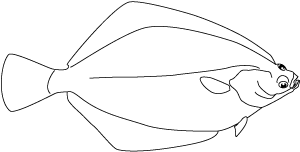
Five species of flatfish are commercially exploited in the Baltic Sea: plaice, flounder, dab, brill and turbot. Only plaice is subject to quotas. Flatfish were mainly by-catch in cod fisheries; there were only small targeted fisheries, e.g. for turbot. Since the closure of the two cod fisheries, flatfish are among the few exploitable target species in the western Baltic Sea. The two plaice stocks in the Kattegat, Belts and Sound and in the Baltic Sea were merged again in 2025 to form a single stock, the "Baltic Sea plaice".
The combined stock is also well within safe limits, with low fishing pressure and high biomass. Plaice seem to benefit in particular from the much lower competition for food due to the poor condition of cod. Reproduction remains strong. The catch recommendation for 2026 is slightly lower than for 2024 and 2025. The catches include discards, which have been largely illegal since 2017 and yet still account for over 20% of the catch from the area.
Since 2022, the plaice caught have been getting thinner, meaning their body condition factor is deteriorating. It is not yet possible to say what role density effects and deteriorating environmental conditions, as in the case of cod, are playing here. The resulting marketing difficulties are making plaice fishing increasingly unattractive. As a result, the maximum catch for plaice is not only far from being exhausted, but is also continuing to decline.
The other flatfish stocks in the western Baltic Sea are also in good condition. However, the income that can be generated from flatfish fishing cannot even begin to compensate for the losses in herring and cod catches.
The explanation of flatfish in the Baltic Sea as a PDF download
Contact: Dr. Sven Stötera

Sprat is one of the species benefiting from the changed environmental conditions in the Baltic Sea. However, the biomass of this currently largest fish stock in the Baltic Sea (a good 570,000 tonnes of spawning biomass) has continued to decline and in 2025 will be only slightly above the reference value for the maximum sustainable yield (MSY). Fishing mortality has increased and thus remains far too high. However, after three weak years, the 2024 year class appears to be strong, and spawning biomass is expected to increase in 2026 and 2027. The catch recommendation for 2026 is therefore 36% higher than for 2025. Stock assessment is becoming more uncertain because Russian data is no longer being reported following Russia's suspension from ICES.
German fisheries exploit this resource with two large (approx. 50 metre long) and a few smaller trawlers, mainly for the production of fishmeal and fish oil.
The explanation of sprat in the Baltic Sea as a PDF download
Contact: Dr. Stefanie Haase
A comprehensive overview of the status of most marine fish stocks of importance to the German market is provided on the German website Fischbestände online.

